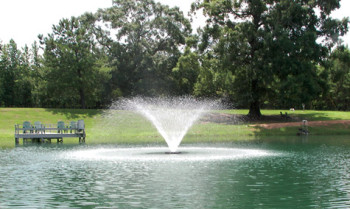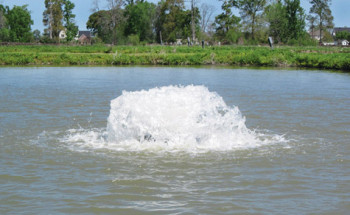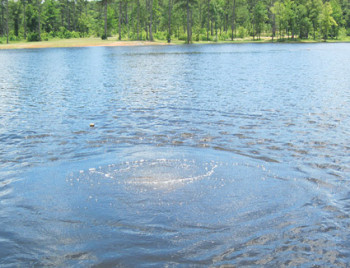Larger ponds benefit in several ways from aeration, which is not only about oxygen levels, but mixing and gas exchange. When aerating larger ponds, there are several approaches and different tools to use based on the pond’s use and the challenges that need to be addressed.
Why Aerate?
So why do we aerate?
1) Aging

Larger ponds are aging and aeration helps to arrest or reverse this process. God doesn’t make ponds; we do. Nature is trying to fill them with material and turn them back into land. Grass clippings, windblown debris, manure from livestock and waterfowl—not to mention the annual drop of fall leaves—all contribute organic material to ponds that is seldom digested completely in an annual cycle. Erosion small and large from rainstorms, un-grassed areas and unprotected shorelines contribute both organic and inorganic material to ponds. This results in filling, increased nutrients and declining water quality as this progresses. Of course, aeration can’t do anything about inorganic soil that washes into a pond, but it stimulates the pond bacteria tremendously and they consume more of the organic, liquid compost at the bottom of the pond. This digested organic material physically leaves the pond as gas byproducts like carbon dioxide and nitrogen. As the higher oxygen content penetrates the top layer of the mud, the cycling of pond nutrients, specifically phosphorus, is buffered and that helps to avoid the overproduction of algae.
2) Natural Bad Behavior
Ponds have varying amounts of oxygen. This is a result of weather conditions, oxygen demand and photosynthesis. As it cycles from high to low, fish may experience high stress periods that can even cause a fish kill in your pond. Low oxygen levels can affect the pond chemistry, rapidly cycling nutrients that can reduce water quality and increase algae growth.
3) Bigger, Healthier Fish
Enough of the nerdy pond chemistry. Aeration grows bigger, healthy fish…faster. The latest research on catfish suggests a 40 percent difference in growth rate from increased aeration. Aeration mixes the water as well as exchanging gases. The water quality in the entire pond becomes consistent, as well as more comfortable for fish. Temperatures, pH, oxygen content and other water chemistry are more uniform and change slowly throughout daily cycles.
The result: fish thrive instead of just surviving.
The Challenge
I am not sure if everyone appreciates the fact that a 1-acre pond with an average depth of 6 feet contains almost 2 million gallons of water. So how do you get enough of that pond moving and in contact with the atmosphere to aerate it? There are several efficient tools to accomplish this—and some of them look great, too! Starting from the bottom:
Diffused Aeration

Diffused aeration uses an onshore compressor supplying air, self-weighted tubing delivering air, and diffusers to break up the air into small bubbles at the bottom of the pond. The small bubbles are not the source of the increased oxygen or much of the gas exchange. Instead, the source of the aeration is the bubbles rising through the water column at a foot per second, carrying large amounts of water to the surface and bringing it in contact with the atmosphere!
The deeper the pond, the more efficient this approach is, since the bubbles have more distance to travel through the water column and entrain the water flow upward. For instance, the most efficient types of diffusers can process approximately 2.5 million gallons of water per day when placed in 12 feet of water! There is nothing to see, as far as display is concerned, with diffused aeration—which may be a benefit for some who prefer a serene setting at their ponds. There is no electrical service in the pond and nothing floating on the surface. You can enjoy fishing, swimming or boating while the system is fully operational. The compressors that supply the air for diffused air systems can be powered by grid electricity, solar or wind power.
Surface Evolution

The pond aeration industry has several submersible direct-drive motors that efficiently process water to drive high-volume aerators, aerating fountains and decorative fountains. Do fountains aerate? Yes, they do; however, it takes energy to make a display pattern, and this energy is not available to make additional volume for the process of aeration. It is like putting your finger over a water hose. It makes a high spray, but the volume is dramatically reduced. So in general, the more decorative an aerating fountain is, the more horsepower it will take to aerate the same size pond.
High-volume surface aerators have a large propeller, designed to efficiently work the motor and churn water at the surface, all as a self-contained, floating unit. As it violently mixes the water and air, an almost complete exchange of gases occurs and the water returns to the pond at equilibrium with the oxygen levels in the atmosphere after expelling carbon dioxide and other harmful gases. The display is a huge gush of water at the surface. It is a simple display, but many people prefer it and some even light them at night with lighting packages.
Aerating fountains adapt a high-volume surface aerator into a simple, trumpet-shaped pattern. The flow is reduced, but the water display can easily reach 10 feet or higher, depending on the horsepower. This is the best compromise between aeration and display. Because of the high flow and large water droplets, this fountain type does a great job of screening noise. This can be a great benefit if you live a little too close to the highway or some other noisy, nearby distraction.

Last but not least are the decorative fountains, which, as we discussed, do aerate as well. These are available in any size, from one-quarter horsepower to 25 horsepower, with corresponding price tags and power consumption. When consulting with pond owners about the type of decorative fountain they are interested in for aeration, the conversation usually becomes a crossroads based on what power is available; what pattern are they interested in; what size, specifically height, they need for a good scale on their pond; and the size of pond that needs to be aerated. In general, 3 horsepower per acre seems to be a good fit. This can be in the form of one 3-horsepower fountain or three 1-horsepower fountains.
Larger ponds have lots of options for aeration. Choose a high-quality aerator and do a safe, professional installation. The pond will benefit, and your enjoyment of the pond will as well.


Thank you for explaining to me that there are many different kinds of aeration and some of them use a propellor that is near the surface to increase the oxygen balance. Yesterday, I was driving past a water treatment pond and the water looked very gross. I think that if I was in charge of the plant I would want something to churn the water.